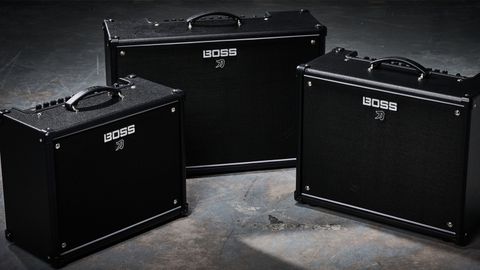MusicRadar Verdict
Brighter, punchier and full of life, the new Katana Gen 3 improves what were already brilliant tones and even adds a new Pushed model that quickly became our favourite. While these amps are not a complete reimagining of the Katana series, they offer a more refined tone with a few extra tone-shaping features that are welcome extras. If we had one criticism, it’s that Bluetooth functionality is an optional extra and requires you to purchase a separate device to utilise it.
Pros
- +
Easy to navigate as always
- +
The new “pushed” clean sound is very nice – great with a Strat or Tele
- +
Overall the tone is clearer with greater detail and nuance
Cons
- -
Bluetooth is an optional extra
MusicRadar's got your back
Boss Katana 50 & 100 Gen 3 review: What is it?
We don’t think anyone would argue that Boss is the reigning king of practice amps, with the Katana the jewel in their crown. From the day it launched in 2016, the Katana showed what was possible with digital technology, ushering in a new era of affordable, feature-laden combos that transformed how many of us rehearse at home. New for 2024, the Katana story continues with the 3rd generation of amplifiers. Now, this is clearly not a complete reforging of the Katana but rather a sharpening of the blade – and an evolution of what has come before.
Now, as you’d expect, the base of the Katana has stayed the same. Still powered by Boss’s clever Tube Logic technology and a reactive Class AB analogue power section, the new Katana promises to behave just like the previous iteration. However, the overall tone of the unit has been enhanced. It now boasts a more detailed sound with improved clarity in the high frequencies, richer harmonics in the mid-range, and a tighter, more defined low-end. It even features a brand new voicing in the form of a “pushed” clean that expands the tonal versatility of an already adaptable amplifier.
New to the Katana 100 – and above – is the Contour switch. This innovative feature allows you to alter the frequency response of the amp, providing a wide range of tone-shaping options. Whether you need to tame the highs and tighten the bass for a more focused sound, or cut the mids and boost the low end for a more aggressive tone, the Contour switch has a setting to help you tune your amp to the room you are performing in. This flexibility ensures that you can always achieve the perfect sound, regardless of the acoustics of your performance space.
Since the amp’s launch, players have been crying out for Bluetooth connectivity and an easier way to edit presets and store their favourite sounds – well, with the Gen 3 Boss has delivered. Each Katana Gen 3 amp features a rear connection specifically for the Boss Bluetooth Audio MIDI Dual Adaptor which enables wireless audio streaming and editing via the new and improved Boss Tone Studio.
Also located on the rear of each amplifier is a clever line out, which is augmented with a collection of microphone sims that Boss calls Air Feel. Not only can you adjust the microphone distance and placement, but you can also adjust the overall ambience, granting you control over the spatial depth for recording or live performances.
Boss Katana 50 & 100 Gen 3 review: Performance & verdict
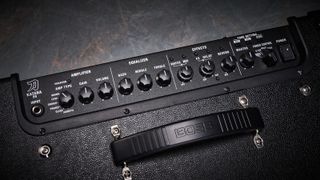
When you power on the Katana Gen 3 for the first time, you'll be greeted by a control layout that's familiar and easy to navigate. Boss has maintained the intuitive design that we're all used to, making it a breeze to cycle through amp models and select effects. If you've used any of the previous iterations, you'll feel right at home with the Gen 3.
Turning our attention to the amp voices, and again we are immediately greeted with tones that we are well and truly acquainted with. From the sparkling chime of the Clean channel to the articulate and responsive Crunch channel and the intense gain of the Brown channel, these amps feel like an old familiar friend – albeit one that's had a little work done!
Overall, the tone of both the 50 and 100 models has a glossy shine to it. These amps are brighter, yes, but there seems to be more there than just enhanced top-end. There's better clarity in the notes, for sure. The amp feels more responsive under your fingers with both units feeling more alive. We'd say the Gen 3 feels like you are viewing the older iteration in 4K – you can definitely notice greater detail and nuance in the tone.
Among our favourite amp models on the new units, there's a new setting that's worth exploring – 'Pushed '. This voice, sitting between Clean and Crunch both physically and stylistically, delivers the sound of a driven valve amp that’s being pushed to the point of very mild breakup. It's a unique addition that can add a new dimension to your playing, and it quickly became our favourite setting on the amp.
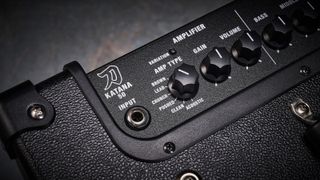
The Katana 100 has an Amp Resonance switch located near the power switch to further shape the amp's tone. Though there is no switch on the Katana 50, these settings are accessible via the Boss Tone Studio. There are three modes to choose from: Vintage, Modern, and Deep. Cycling through the settings offers distinct cab responses that will better suit the environment you are in. For our situation, we preferred the vintage setting, as it sounded the most natural to our ears.
When it comes to the effects, nothing has really changed – if it ain't broke, why fix it? All the standard stomps you know and love are represented and are allocated to the same dials as before. Of course, if you want to get creative with your effects, you can fine-tune your settings in the Tone Studio app – something that's just got a little easier with the most hotly anticipated new feature on the Gen 3, Bluetooth.
As we previously mentioned every new Katana is equipped with a designated connection specifically for the Boss BT Dual adaptor which allows you to wirelessly pair to a mobile device to use with the Boss Tone Studio, as well as stream audio for playing along with backing tracks. It's worth noting that this is an optional extra, and the device retails for around £45.
Now, for the purposes of this review, Boss sent us the Bluetooth dongle, and while it worked exactly as advertised, we couldn't help but wonder why this feature couldn't be built directly into the amp. The practice amp space is a rather crowded one, and Boss is competing with a lot of different amps, a lot of which have this feature built-in. Models such as the Positive Grid Spark, Fender Mustang and Yamaha THR all offer Bluetooth streaming. This isn't a new technology, and when your amplifier utilizes an app for deeper editing, the majority of consumers will expect this as standard. Maybe we'll see it on the Gen 4.
Final verdict
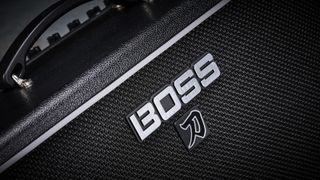
It's no secret that we loved the previous iteration of the Boss Katana, and our admiration of this humble digital modelling amp hasn't changed with the latest release. Players looking for a complete redesign will be left disappointed, as this is more of an evolution rather than a revolution.
That said, there's still a lot to like with the Gen 3. The tones have an extra layer of polish, with an added depth and sheen. The addition of the Pushed channel is a welcome one, as in a very short period of time, it has become one of our favourite channels on the amp. We also love that the Tone Studio has received a much-needed facelift, and you can access it via Bluetooth – although we'd rather not have to pay for an additional piece of tech for the pleasure.
At the end of the day, the Katana Gen 3 is a great-sounding, feature-laden amplifier that is perfect for home practice, taking to the stage or recording, and this new version proves why Boss is still the king of the space.
Boss Katana 50 & 100 Gen 3 review: Hands-on video
MusicRadar
Boss Katana 50 & 100 Gen 3 review: Specifications
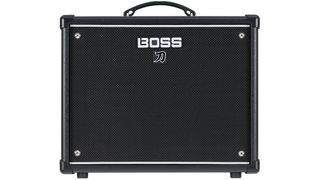
Boss Katana 50
- Rated Power Output: 50W
- Speaker: 30 cm (12 inches) x 1
- Amp types: ACOUSTIC, CLEAN, PUSHED, CRUNCH, LEAD, BROWN
- Dimensions: 470 (W) x 238 (D) x 398 (H) mm
- Weight: 11.6 kg
- Contact: Boss
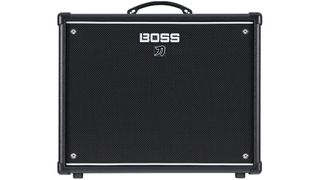
Boss Katana 100
- Rated Power Output: 100W
- Speaker: 30 cm (12 inches) x 1
- Amp types: ACOUSTIC, CLEAN, PUSHED, CRUNCH, LEAD, BROWN
- Dimensions: 530 (W) x 248(D) x 484(H) mm
- Weight: 14.8 kg
- Contact: Boss

I'm a Senior Deals Writer at MusicRadar, and I'm responsible for writing and maintaining buyer's guides on the site - but that's not all I do. As part of my role, I also scour the internet for the best deals I can find on gear and get hands-on with the products for reviews. My gear reviews have been published in prominent publications, including Total Guitar and Future Music magazine, as well as Guitar World.com. I've also had the privilege of interviewing everyone from Slash to Yungblud, as well as members of Sum 41, Foo Fighters, Feeder, Fever 333 and many more.
I have a massive passion for anything that makes a sound, particularly guitars, pianos, and recording equipment. In a previous life, I worked in music retail, giving advice on all aspects of music creation and selling everything from digital pianos to electric guitars, entire PA systems, and ukuleles. I'm also a fully qualified sound engineer who holds a first-class Bachelor's degree in Creative Sound Production from the University of Abertay and I have plenty of experience working in various venues around Scotland.

Issue 339 of Computer Music is on sale now

“The most expressive synth of its time, redesigned”: Has Softube created an authentic Yamaha CS-80 emulation that’s more user-friendly than the original?

"Make your own high-quality models and load them straight into your session": This free plugin brings AI voice modelling to your DAW
